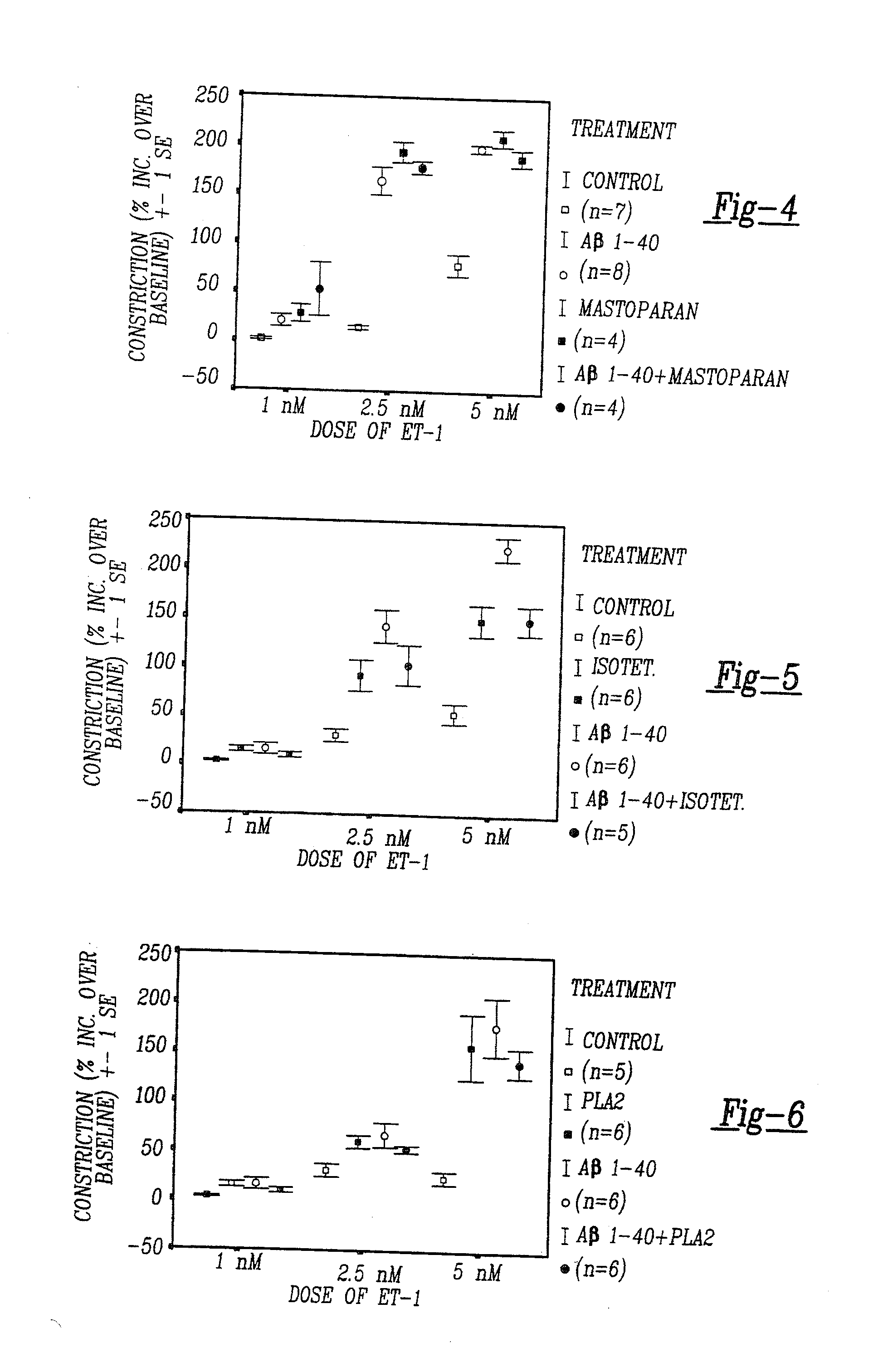Modulation of the Phospholipase A2 Pathway as a Therapeutic
a phospholipase and pathway technology, applied in the field of phospholipase a2 pathway modulation as a therapeutic, can solve the problems of unconventional detection of such neurotoxic effects, the role of alzheimer's disease and other diseases, and the mechanism of action of alzheimer's disease, etc., and achieve the effects of enhancing et-1 induced vasoconstriction
- Summary
- Abstract
- Description
- Claims
- Application Information
AI Technical Summary
Benefits of technology
Problems solved by technology
Method used
Image
Examples
example 1
[0066]The following example demonstrates that soluble Alzheimer's β-amyloid peptides mediate vasoactivity through a pro-inflammatory pathway, the phospholipase A2 / arachidonic acid / 5-lipoxygenase / cyclo-oxygenase-2 cascade. Furthermore, this example shows that blocking specific target molecules on this pathway oppose the effect of soluble Aβ peptides (1-40 and 1-42) in the vasculature.
Materials and Methods
[0067]The compounds used in vasoactivity assays include: Porcine pancreatic PLA2 (sPLA2), melittin, mastoparan and ET-1 were purchased from Sigma. Isotetrandrine, MK-886, RHC-80267, diacylglycerol (DAG), oleyloxyethylphosphocholine (oleylox.), bisindolylmaleimide I (bisindol.), PD98059, SB202190, methyl arachidonyl fluophosphonate (MAFP), quercetin, haloenol lactone suicide substrate (HELSS), AACOCF3 and NS-398 were obtained from Calbiochem. Aβ1-40 and Aβ1-42 were obtained from QCB. MK-886, RHC-80267, DAG, bisindol., PD98059, SB202190, MAFP, quercetin, HELSS, AACOCF3, NS-398, Aβ1-40 ...
example 2
[0115]The following example serves to illustrate that the sPLA2 / AA / 5-LOX / COX-2 pathway is also activated by soluble Aβ peptides in microglia, providing for an additional system where Aβ peptides stimulate this pathway. Additionally, this example illustrates that substances which inhibit this pathway block the effect of Aβ in microglia.
Methods
[0116]Leukotriene B4 (LTB4) enzyme-linked immunoabsorbant assay (ELISA). Quantitative determination of LTB4 levels was made using a competitive binding ELISA (R&D Systems, Minneapolis, Minn.) designed to measure LTB4 in cell culture supernatants (as described in Paris et al., Exp Neurol 1999). A murine microglial cell line (N9) was provided by Dr. Paola Ricciardi-Castagnoli (Cellular Pharmacology Center, Milan, Italy) and were grown in RPMI medium supplemented with five percent fetal calf serum, 2 mM glutamine, 100 U / mL penicillin, 0.1 μg / mL streptomycin and 0.05 mM 2-mercaptoethanol. Microglial cells were seeded at 50,000 cells / well in 6-well p...
example 3
[0123]This example illustrates the effect of soluble Aβ on a neuronal model (NGF-β differentiated PC12 cells). The data presented here, like those in example 2, demonstrate that soluble Aβ peptides stimulate the sPLA2 / AA / 5-LOX / COX-2 pathway. In this example it is further highlighted that soluble Aβ peptides are able to trigger the pathway in various cell types.
Methods
[0124]Measurement of [3H]AA release in neuronal cells (cultured differentiated PC12 cells). A rat pheochromocytoma cell line (PC12) was grown in Kahn's modification of F12 medium supplemented with 10% fetal calf serum, 100 U / mL penicillin and 0.1 gg / mL streptomycin. PC12 cells were seeded at 35,000 cells / well and differentiated with 60 ng / mL NGF-β for 5-6 days and then maintained with 5 ng / mL NGF-β thereafter. PC12 cells were treated with 0.4 μCi / mL of [3H]AA for 18 h and were washed multiple times with 1 mL of complete medium to remove unincorporated [3H] AA. Cells were then treated with 1 μM of Aβ1-40 or 40 U / mL of sP...
PUM
| Property | Measurement | Unit |
|---|---|---|
| molecular mass | aaaaa | aaaaa |
| pH | aaaaa | aaaaa |
| total volume | aaaaa | aaaaa |
Abstract
Description
Claims
Application Information
 Login to View More
Login to View More - R&D
- Intellectual Property
- Life Sciences
- Materials
- Tech Scout
- Unparalleled Data Quality
- Higher Quality Content
- 60% Fewer Hallucinations
Browse by: Latest US Patents, China's latest patents, Technical Efficacy Thesaurus, Application Domain, Technology Topic, Popular Technical Reports.
© 2025 PatSnap. All rights reserved.Legal|Privacy policy|Modern Slavery Act Transparency Statement|Sitemap|About US| Contact US: help@patsnap.com



